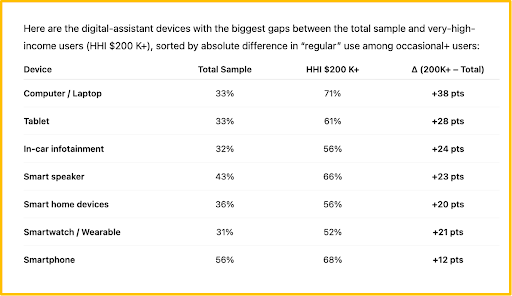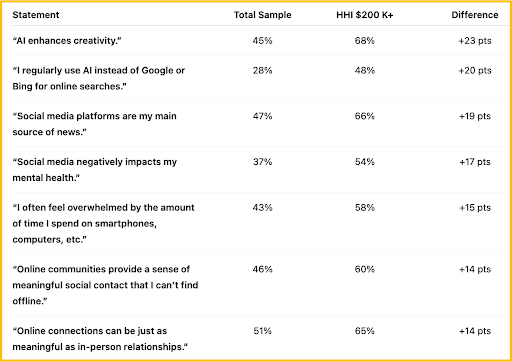High Income Households Lead in AI Adoption…and Digital Anxiety

This is the 5th in our series reviewing NuVoodoo research about the media habits of high-earning households. Parts 1 – 4 are available at nuvoodoo.com/articles.
In our final deep-dive into the digital habits of America’s wealthiest households (those earning over $200,000 or more annually), NuVoodoo’s survey of 2,908 U.S. consumers paints a vivid picture: compared to our total sample covering a representative range of US household incomes, high-earners don’t just try new tech—they integrate it into every facet of their lives. By stitching together agree/disagree attitudinal response data with usage patterns arising from queries about their use of AI tools, voice assistants, and smart devices, one truth stands out: the $200k+ household segment is not only more enthusiastic about cutting-edge innovations but also more reliant on them and anxious about them than the general population.
Embracing AI in all its forms
High earners are far more bullish on AI’s creative potential (68% vs 45%) and much more likely to be using AI in place of traditional search engines (+20 points). Nearly half (47%) of these high earners would rather listen to a polished, AI-generated podcast host than a real person—more than double the rate of the general public
Only 28% of $200k+ HH go untouched by any standalone AI tool. ChatGPT leads the charge (52% regular use), followed closely by Google Gemini (44%) and Amazon’s AI suite (30%). In short, affluent consumers are doing more than just sampling AI; they’re making it their go-to for search, content, and creativity.

Voice assistants everywhere you look
Voice-driven and increasingly-powered interfaces are another clear favorite. Only 18% of high earners never use Siri, Alexa, or Google Assistant—half the overall rate—and more than a quarter use them often. But they don’t stop at smartphones: among those who use voice assistants at least occasionally, 71% deploy them on their computers or laptops, 61% on tablets, and over 50% in cars, smart speakers, and even wearables. In wealthier homes, voice controls extend from the office to the living room to the driver’s seat.

Digital confidence paired with digital anxiety
This group also feels the flipside of constant connectivity. They’re more likely than average to feel overwhelmed by screen time and are quick to acknowledge social media’s negative mental-health impact.

High earners are far more bullish on AI’s creative potential (68% vs 45%) and much more likely to be using AI in place of traditional search engines (+20 points). They rely on social platforms for news at a much higher rate (+19 points), yet are also more aware of social media’s negative mental-health impacts Affluent respondents report being more greatly overwhelmed with screen time (+15 points), but also place more value on online communities and connections as meaningful social outlets (+14 points on each) compared to our total sample.
The net effect is a tech-savvy cohort that simultaneously champions innovation and understands its pitfalls.
Implications for advertisers
Very-high-income households are redefining what “digital native” means. They’re quick to trust AI for content and research, they lean on voice commands across every device they own, and they balance technological optimism with a clear-eyed sense of its downsides. For brands and creators targeting this segment, the message is simple: deliver seamless, AI-powered experiences everywhere—because these users expect their technology ecosystem to be as wealthy and varied as their lifestyles.
NuVoodoo conducts custom research for clients and helps them put insights learned into action. It’s easy to get in touch with our team. Reach us at tellmemore@nuvoodoo.com. We’d love to be a part of your team.




